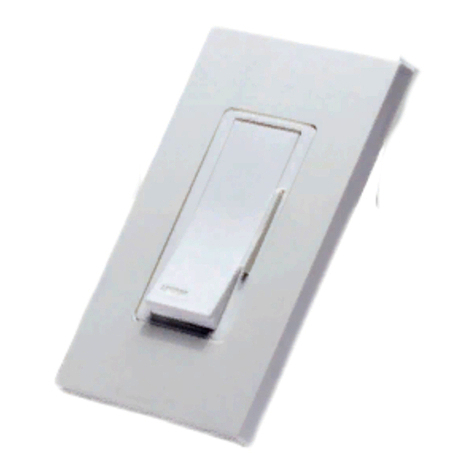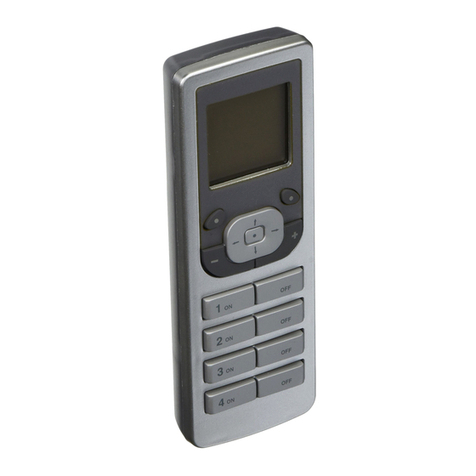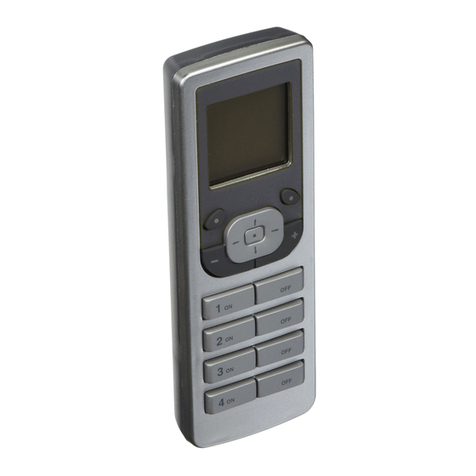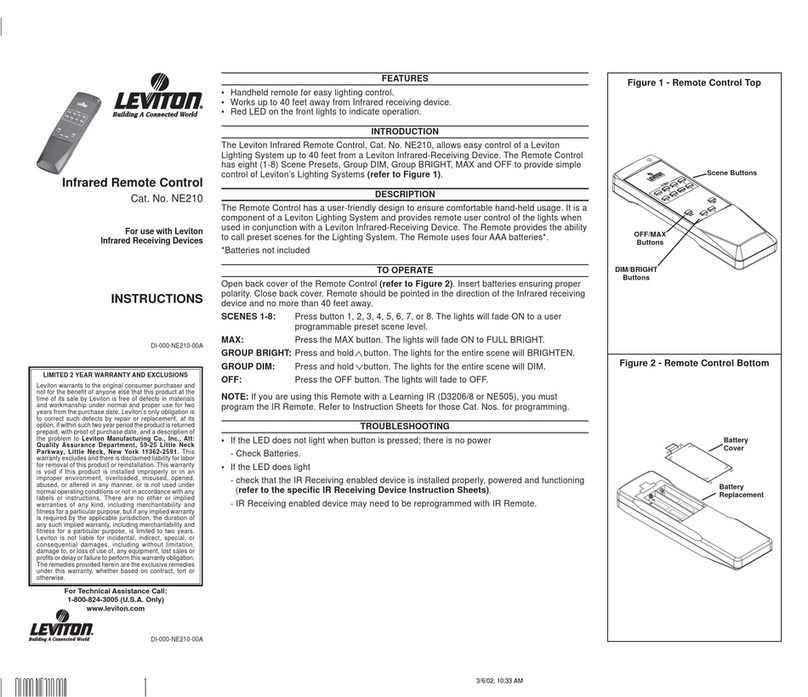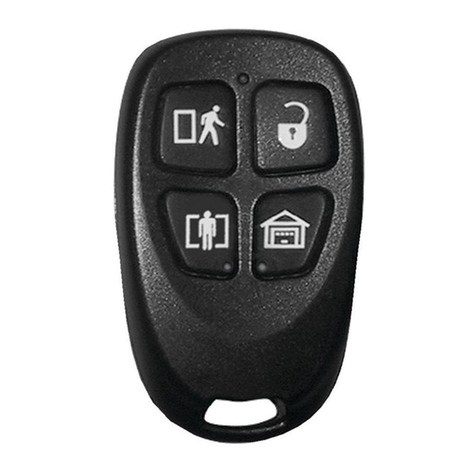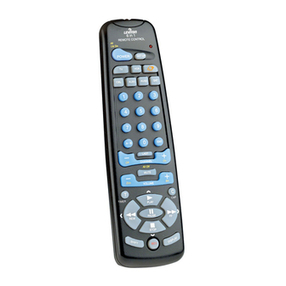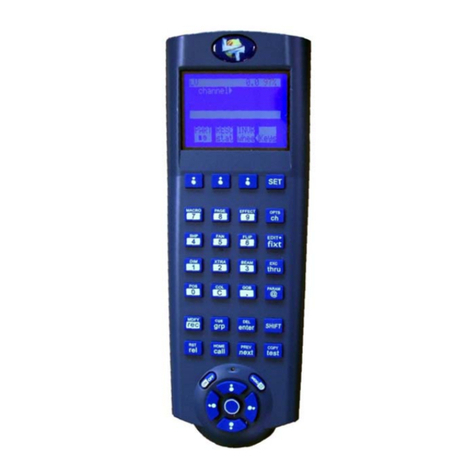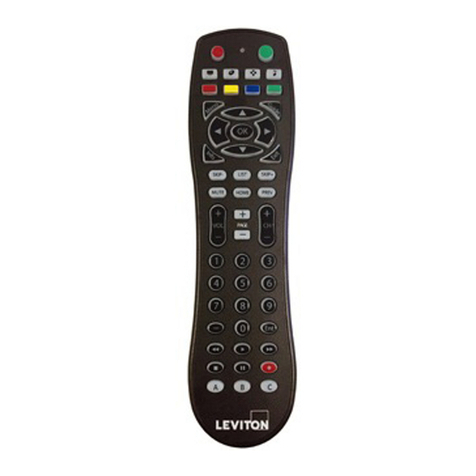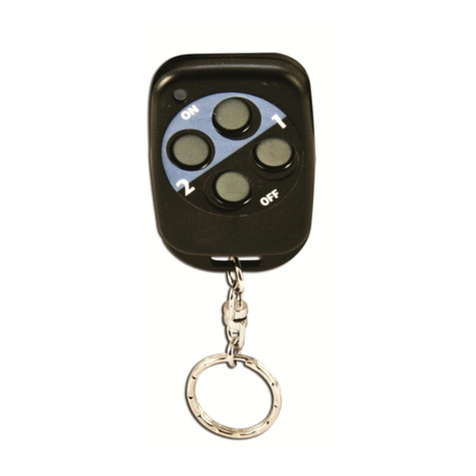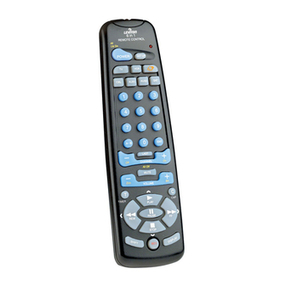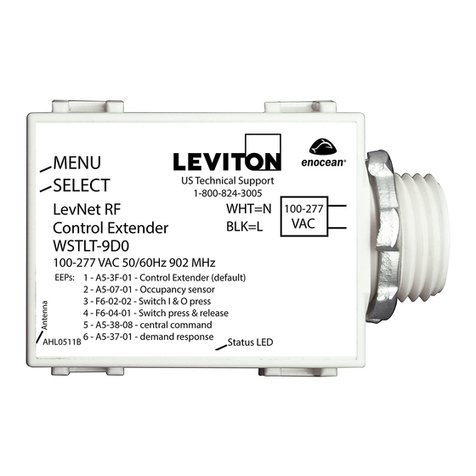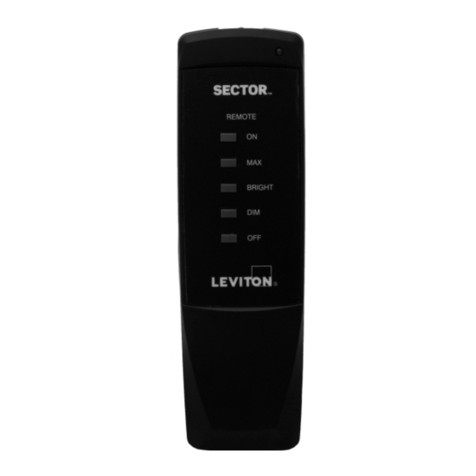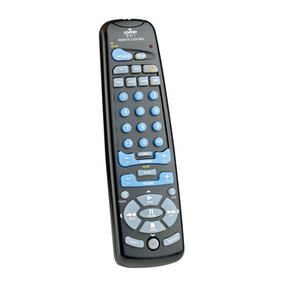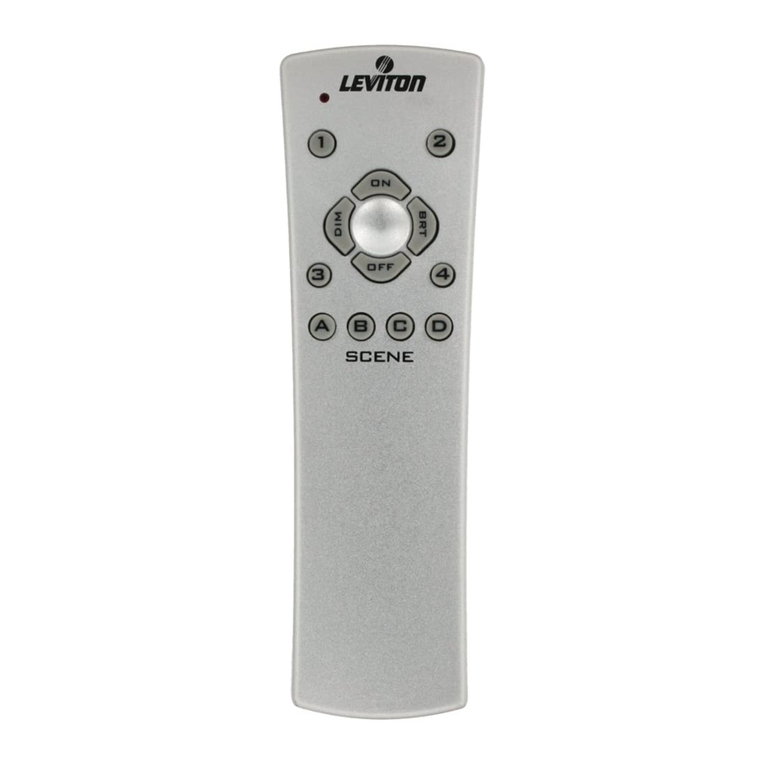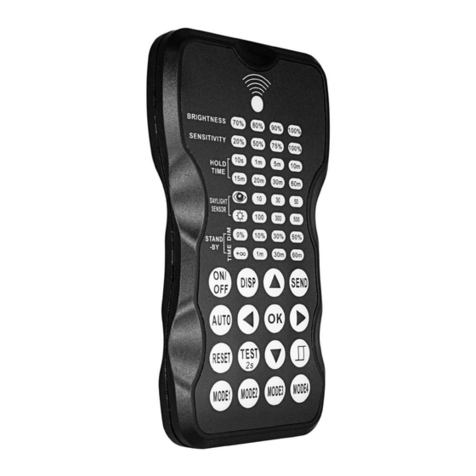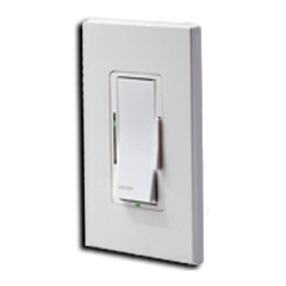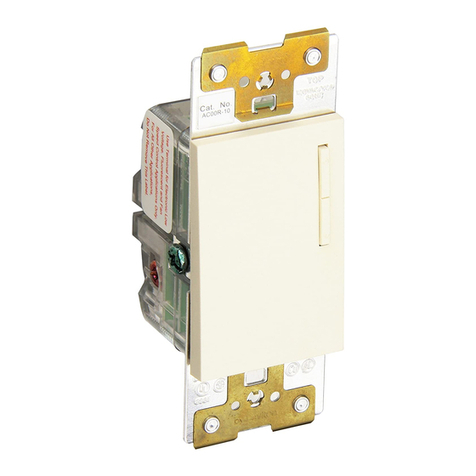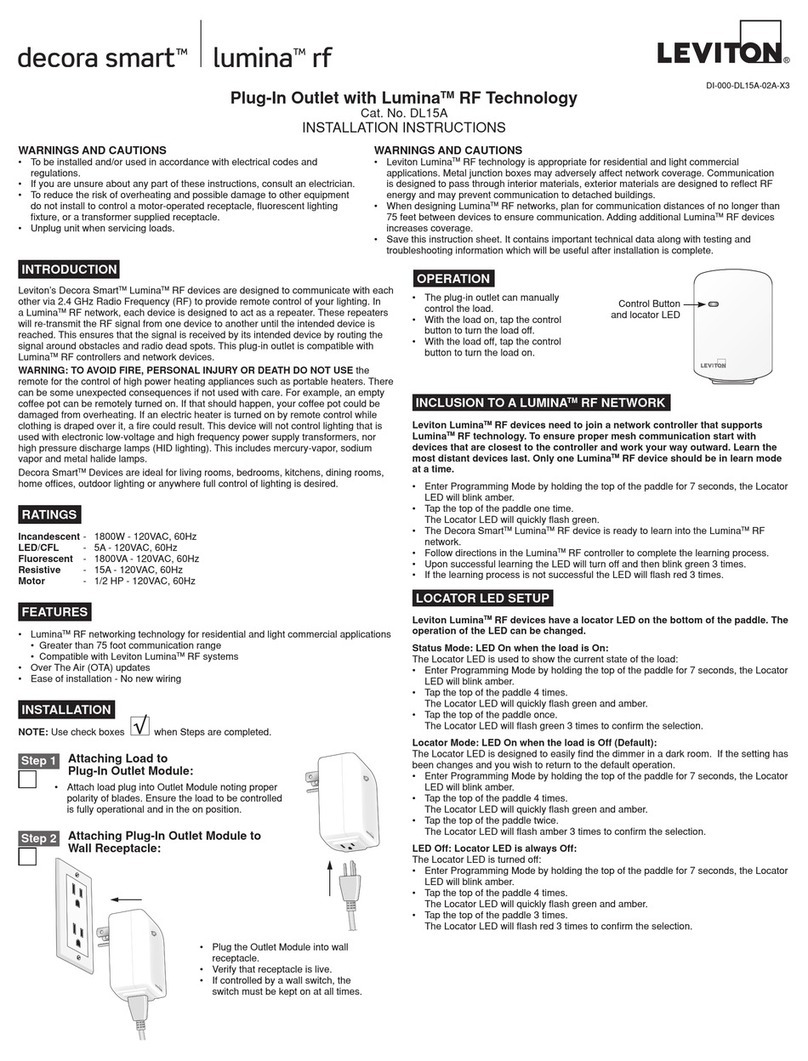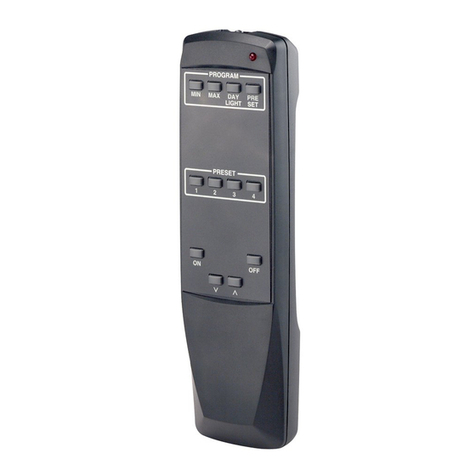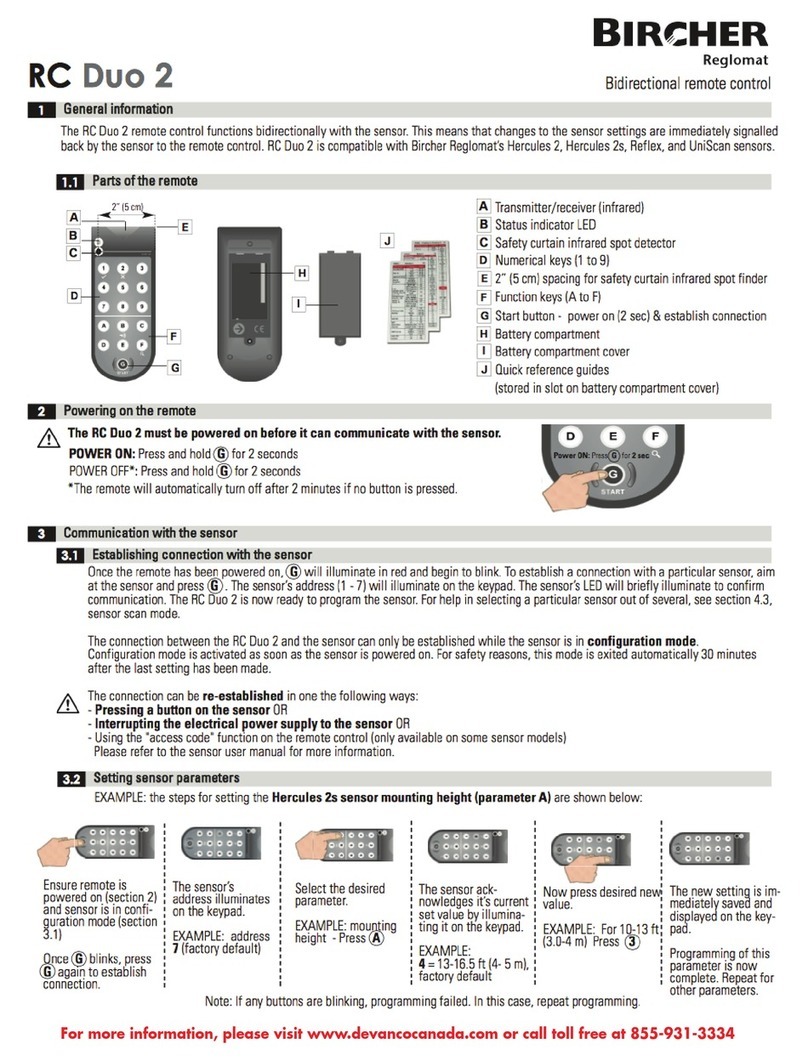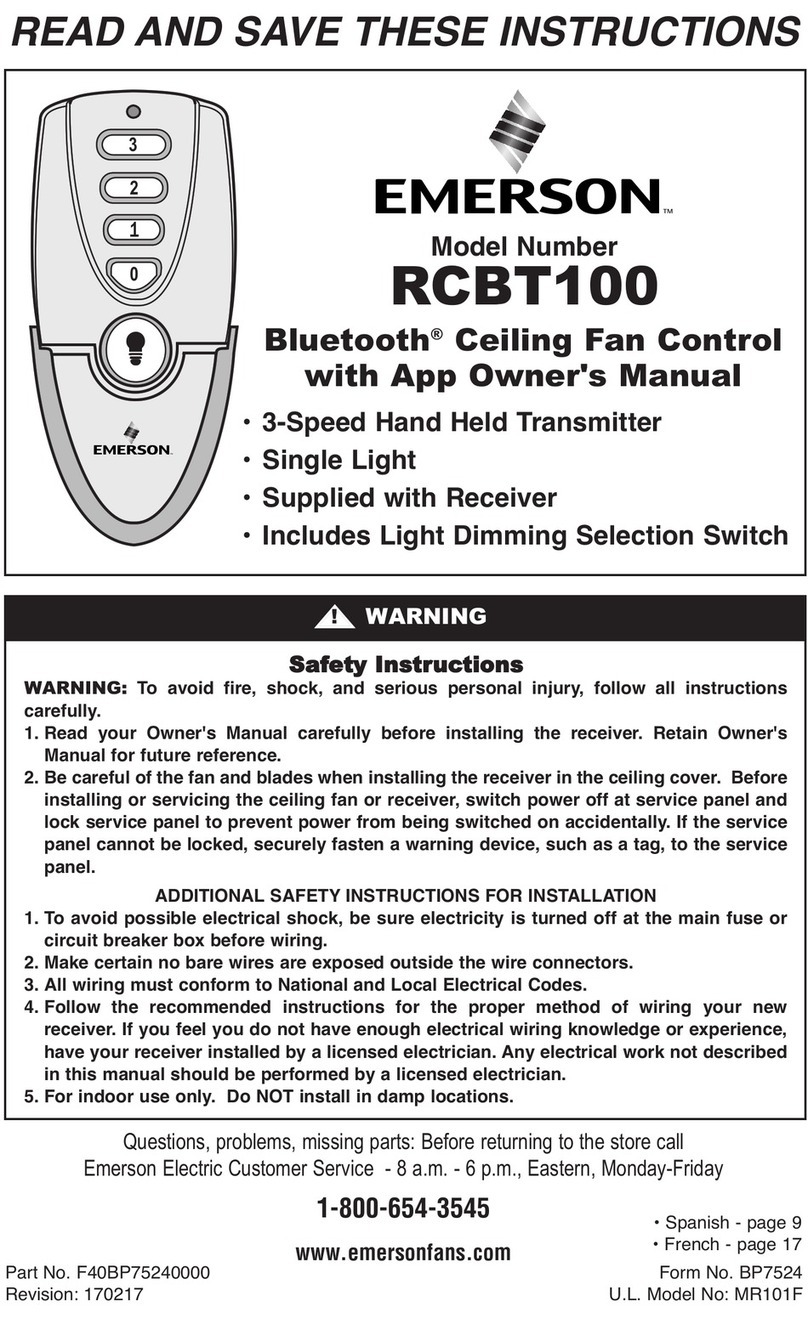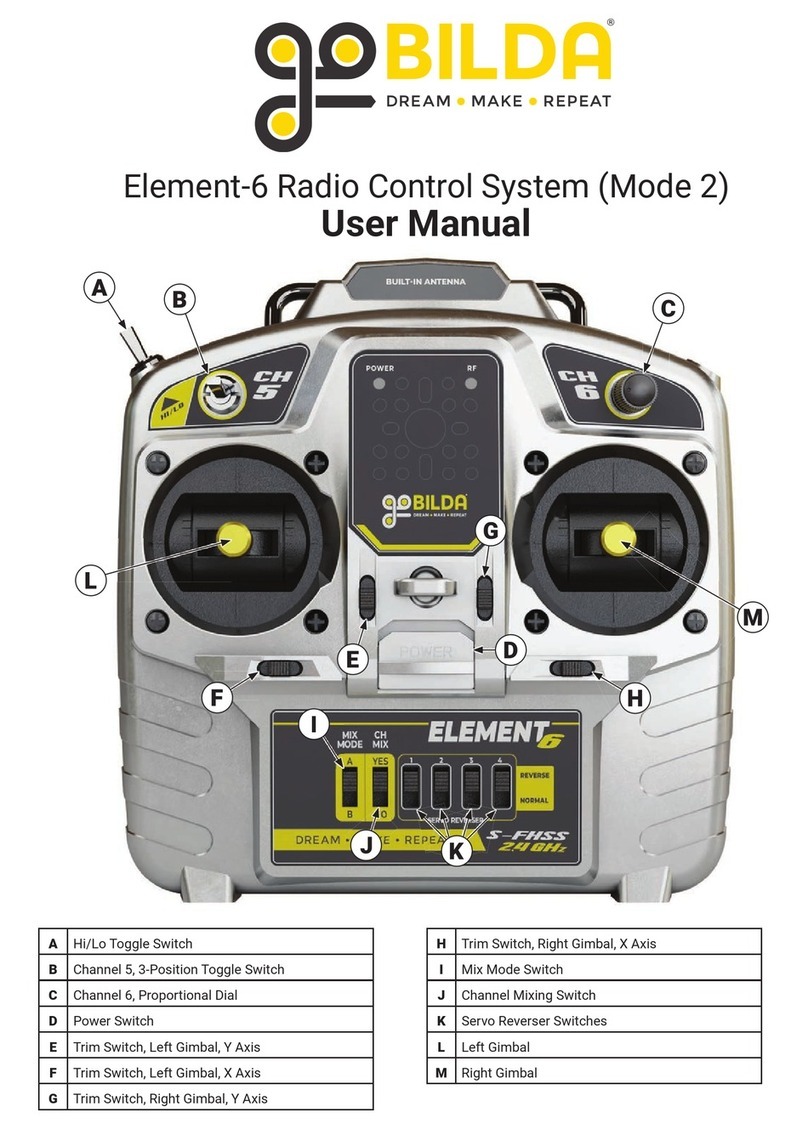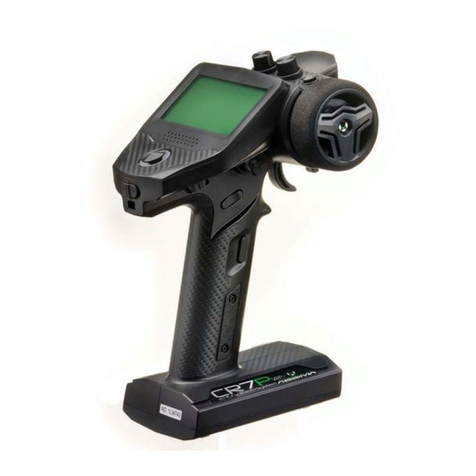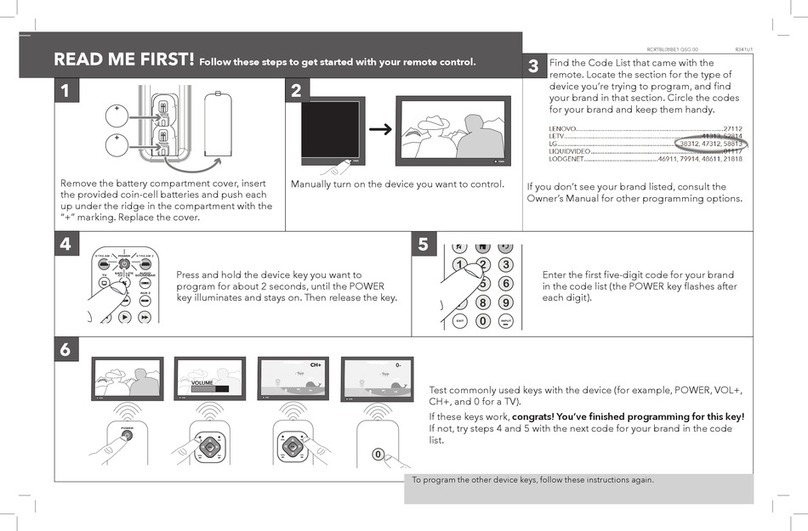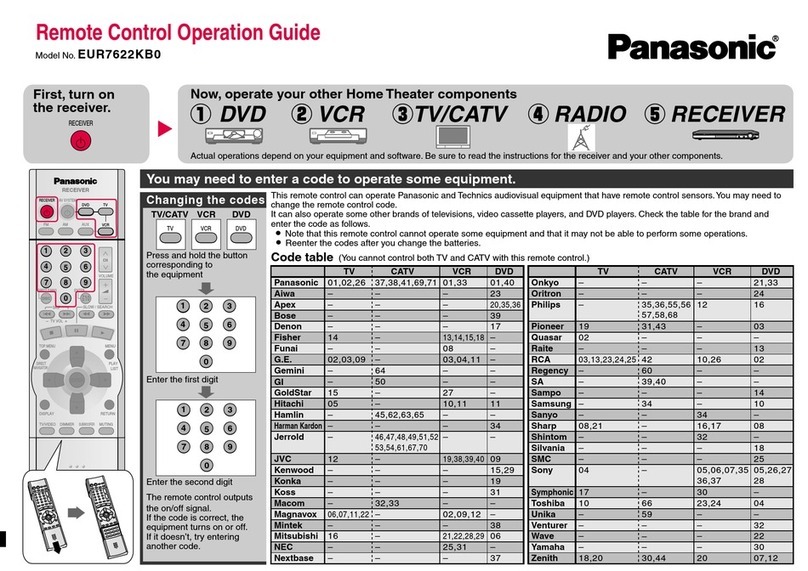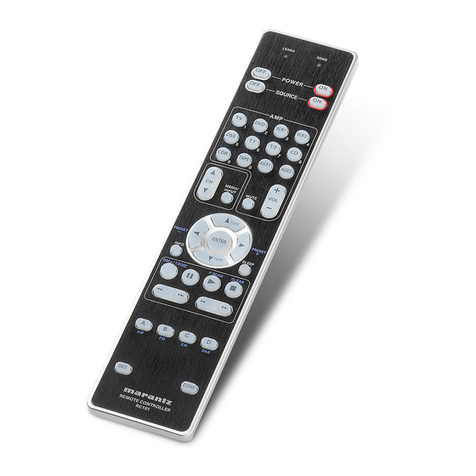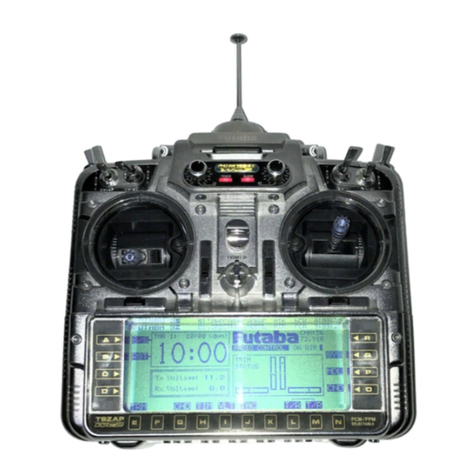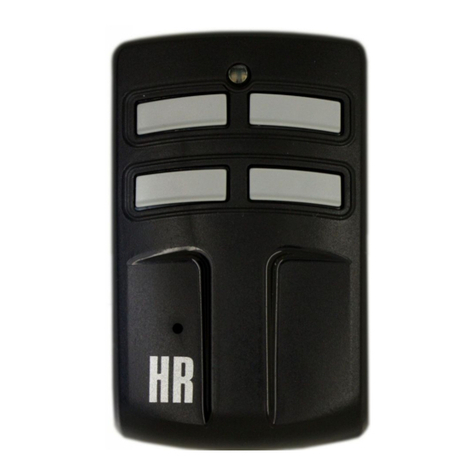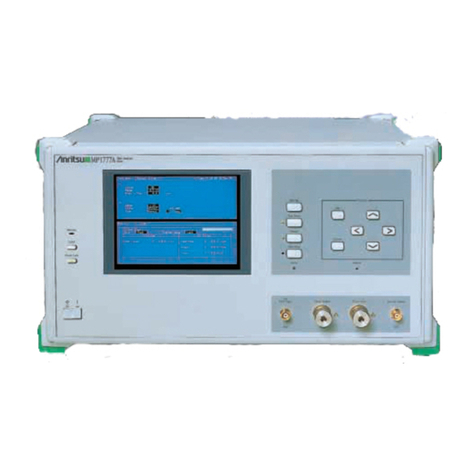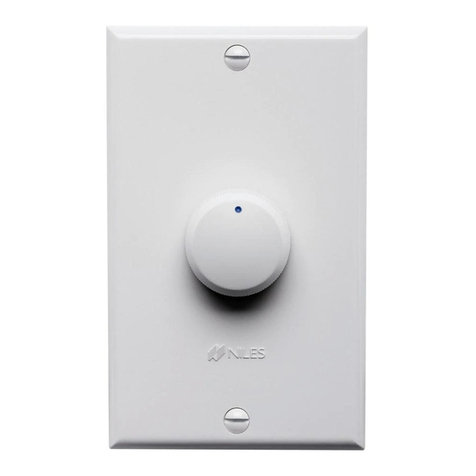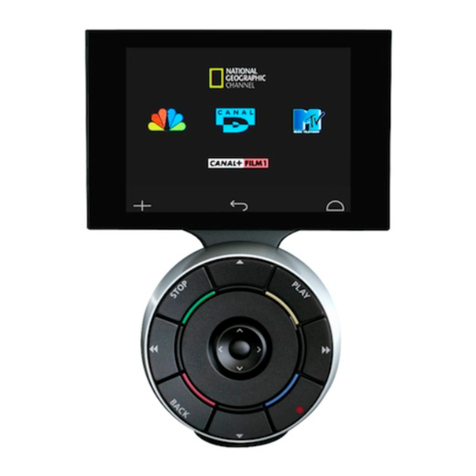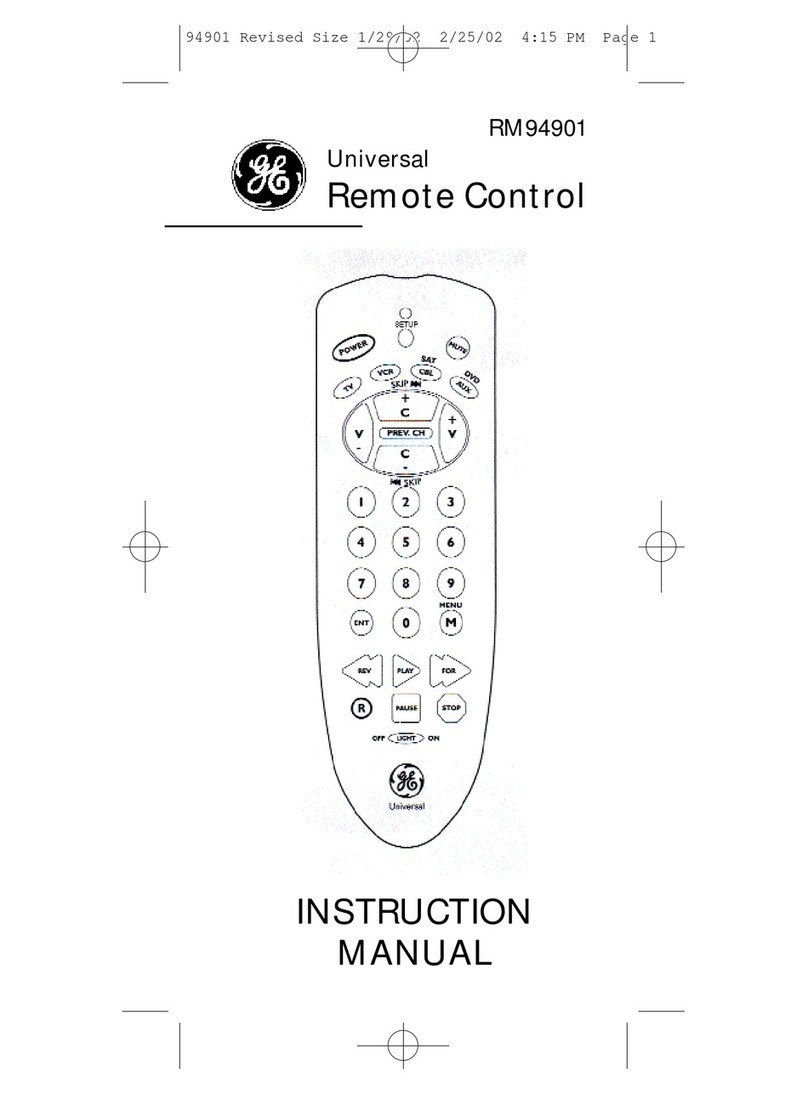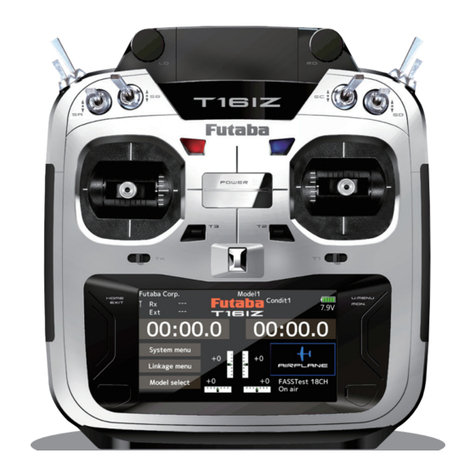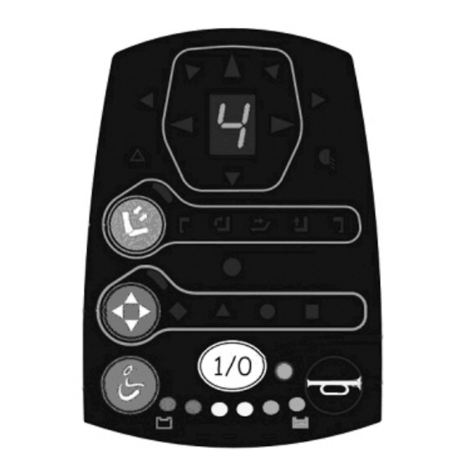
LIMITED 5 YEAR WARRANTY AND EXCLUSIONS
Leviton warrants to the original consumer purchaser and not for the benefit of anyone else that this product at the time of its sale by Leviton is free of defects in materials and workmanship under normal and proper use for five years from the purchase date. Leviton’s only obligation is to correct such defects by repair or replacement, at its option, if within such five year period the product is returned prepaid, with proof of purchase date, and a description of the
problem to Leviton Manufacturing Co., Inc., Att: Quality Assurance Department, 59-25 Little Neck Parkway, Little Neck, New York 11362-2591. This warranty excludes and there is disclaimed liability for labor for removal of this product or reinstallation. This warranty is void if this product is installed improperly or in an improper environment, overloaded, misused, opened, abused, or altered in any manner, or is not used under normal operating conditions
or not in accordance with any labels or instructions. There are no other or implied warranties of any kind, including merchantability and fitness for a particular purpose, but if any implied warranty is required by the applicable jurisdiction, the duration of any such implied warranty, including merchantability and fitness for a particular purpose, is limited to five years. Leviton is not liable for incidental, indirect, special, or consequential damages,
including without limitation, damage to, or loss of use of, any equipment, lost sales or profits or delay or failure to perform this warranty obligation. The remedies provided herein are the exclusive remedies under this warranty, whether based on contract, tort or otherwise.
Testing your Sensor prior to completely mounting in wall box:
NOTE: Dress wires with a bend as shown in diagram to relieve stress when
mounting device.
Step 6
1. If there is no response from the unit and the LED never blinks or the push button
does not activate the lights 1 1/2 minutes after power is applied, then uninstall
device and verify wiring (Step 5).
2. If the lights constantly stay ON, even when the room is unoccupied:
A. Check the Time setting. See how this time compares to how long the lights
stay ON.
B. Try lowering the Range Control. Rotate the knob counter-clockwise about 30˚.
C. If the problem persists, try reducing again. Note: Do Not reduce so much that
Cat. No. ACP
Ø
R cannot see normal occupancy.
D. Be sure to use the Blinders to block any unwanted hallway traffic.
E. Check for reflected heat/motion as Sensor Unit may be seeing motion through
a window.
F. Check for adjacent HVAC and/or heater ducts.
TROUBLESHOOTING
DI-000-ACP0R-00A
Range
Time
1 2
3
4 7
10
Slash Mark
Control Panel Cover
Blinder Adjustment Levers
Sensor Features Diagram
Sensor Mounting:
TURN OFF POWER AT CIRCUIT BREAKER OR FUSE.
NOTE: This device must be installed with the AcentiTM Alignment Plate.
The Alignment Plate is packaged with the AcentiTM Wallplate, which is sold
separately from this device.
Step 7
OPERATION
Cat. No. ACP
Ø
R-CB has a push-button switch that will toggle the lights ON and OFF
(refer to diagram). The lights will not turn ON automatically with occupancy. If the
lights are OFF, the lights will turn ON when the button is pressed, and remain ON in the
presence of motion. The Sensor will turn the lights OFF either in the absence of motion
or when the button is pressed. If motion is detected within 30 seconds after the lights
have turned OFF due to absence of motion, the lights will turn back ON. If 30 seconds
expires when lights have turned OFF due to absence of motion, the lights will then have
to be turned ON manually.
NOTE: This feature does not apply when the lights are manually turned off.
NOTE: The Motion Indicator LED will blink every 2 seconds while motion is detected.
Field-of-View (Horizontal)
30 ft. (9.1 m)
30 ft. (9.1 m)
Side (Vertical) Field-of-View
30 ft.
(9.1 m)
4 ft.
(1.2 m)
Sensor Unit
U.S. & Foreign Patents Pending
Copyright© 2007 Leviton Manufacturing Co., Inc.
All Rights Including Trade Dress Rights Reserved
For additional information, contact the Acenti™ Information Hotline at
1-888-4-ACENTI or visit Leviton’s website at www.leviton.com/acenti
Wall Surface
Mounting
Screws
(2 places)
Sensor
Alignment Pin
(2 places)
Mounting Screw
(remove if applicable)
Adapter Plate
NOTE: Dress wires with a bend as shown in diagram in order to relieve stress when
mounting device. Ensure tab of Alignment Plate is on bottom.
• If Alignment Plate is temporarily positioned using screw as in Step 4A, remove screw
at this point.
• Position all wires to provide room in outlet wall box for device.
• Ensure that the word “TOP” is facing up on both the alignment plate and device strap.
• Position device so that the alignment holes fit on alignment pins as shown. Press
device onto Alignment Plate until strap sits flat.
• Align the two star patterned alignment holes of the Adapter Plate over the two pins of
the Alignment Plate. Gently press Adapter Plate onto Alignment Plate until Adapter
Plate sits flat.
• Tighten mounting screws into wall box so that device remains flat on Alignment Plate.
• CAUTION: DO NOT over-tighten device mounting screws. Overtightening will cause
improper mounting and alignment. Using a high-torque power screwdriver is not
recommended. Alignment Plate must sit flush on wall surface.
NOTE: For multi-device applications, refer to Wallplate Instruction Sheet.
Alignment Pin into
Alignment Hole
Pin and Alignment
Hole engaged
(2 places)
Strap must sit flat
on Alignment Plate
Wall surface
Wallplate
Notch on bottom
Wallplate Mounting:
Mounting: With notch facing down, press on Acenti™ wallplate (sold separately).
Removal (if necessary): Using a small screwdriver, place in notch in bottom of
wallplate and gently lift up to remove.
Step 8
Restore Power:
Restore power at circuit breaker or fuse.
Installation is complete.
Step 9
Lens
Push
Button
LED
Window
Blinders
Control
Panel
Cover
This equipment has been tested and found to comply with the limits for a Class B
Digital Device, pursuant to Part 15 of the FCC Rules. These limits are designed to
provide reasonable protection against harmful interference in a residential installation.
This equipment generates, uses, and can radiate radio frequency energy and, if not
installed and used in accordance with the instructions, may cause harmful interference
to radio communications. However, there is no guarantee that interference will not
occur in a particular installation. If this equipment does cause harmful interference to
radio or television reception, which can be determined by turning the equipment OFF
an ON, the user is encouraged to try to correct the interference by one or more of the
following measures:
• Reorient or relocate the receiving Antenna.
• Increase the separation between the equipment and the receiver.
• Connect the equipment into an outlet on a circuit different from that to which the
receiver is connected.
• Consult the dealer or an experienced radio/tv technician for help.
FCC COMPLIANCE STATEMENT
3-Way Wiring with Sensor Remote for Controls with
Neutral Connection Application:
Note: Electgronic Low-Volatge, Mark10TM and Electronic Switch
installation only.
Step 5d
BK WH
YL/RD
RD
4
3
5
Additional
Neutral Wire
Control
Sensor Remote
4
3
5
1
2
Black
Green
White
Red
Yellow/Red
1
2
Terminal
Screw marked
Black (BK)
Terminal
Screw marked
White (WH)
Terminal Screw
marked Yellow/Red
(YL/RD)
Hot (Black)
Neutral (White)
ControlSensor Remote (with LEDs)
YL/RD
Yellow/Red
Red
WH
BK Black
Black
White
Load
Line
120VAC, 60Hz
Green
Ground
Green
Ground
White
NOTE: The control must be installed in a wall box that has a Load connection. The sensor
remote must be installed in a wall box with a Line Hot connection and a Neutral connection. A
Neutral wire to the sensor remote needs to be added as shown.
If you are unsure about any part of these instructions, consult a qualified electrician.
NOTE: Maximum wire length from control to all installed remotes cannot exceed 300 ft (90 m).
WIRING SENSOR REMOTE (wall box with Line Hot connection):
Connect wires per WIRING DIAGRAM as follows:
•Green or bare copper wire in wall box to Green terminal screw.
•
Line Hot (common) wall box wire identified (tagged) when removing old switch and First
Traveler to terminal screw marked “BK”.
•
Second Traveler wall box wire from control to remote terminal screw marked “YL/RD”
(note wire color). This traveler from the remote must go to terminal screw marked “YL/RD”.
• Line Neutral wall box to remote terminal screw marked “WH”.
WIRING CONTROL (wall box with Load connection):
Connect wires per WIRING DIAGRAM as follows:
•Green or bare copper wire in wall box to Green terminal screw or Green control lead.
•
Load wall box wire identified (tagged) when removing old switch to terminal screw marked
“RD” or Red control lead.
• First Traveler Line Hot to terminal screw marked “BK” or Black control lead.
• Remove Red insulating label from terminal screw marked “YL” or Yellow/Red control lead.
•
Second Traveler wall box wire (note color as above) to terminal screw marked “YL/RD” or
Yellow/Red control lead. This traveler from the control must go to the terminal screw on the
remote marked “YL/RD”.
• Line neutral wall box wire to terminal screw marked “WH” or White control lead.
• Proceed to Step 6.
4-Way Wiring with Sensor Remote for Controls with
Neutral Connection Application:
NOTE: Electronic Low-Voltage, Mark 10™ and Electronic Switch installations only.
NOTE: Dimmer is depicted.
Step 5e
BK WH
YL/RD
RD
BK WH
YL/RD
RD
4
3
5
Additional
Neutral Wire
4
3
5
1
2
Black
Green
White
Red
Yellow/Red
1
2
4
3
2
Terminal
Screwmarked
White(WH)
Terminal
Screwmarked
White(WH)
Terminal
Screwmarked
Yellow/Red
(YL/RD)
Terminal
Screwmarked
Black(BK)
6
1
5
Sensor Remote
(3-Way Wall box from Step 2)
Sensor Remote
(4-Way Box from Step 2)
Control
(3-Way Wall Box from Step 2)
Terminal
Screwmarked
Yellow/Red
(YL/RD)
Terminal
Screwmarked
Black(BK)
Hot (Black)
Neutral (White)
Control
Sensor Remote
(with LEDs)
Sensor Remote
(with LEDs)
YL/RD YL/RD
RD
BK
BK
YL/RD
WH WH
WH
BK
Line
120VAC, 60Hz
Green
Ground
Green
Ground
Green
Ground Black
White
Load
NOTE: The control must be installed in a wall box that has a Load connection. The sensor
remote must be installed in a wall box with a Line Hot connection and a Neutral connection. A
neutral wire to the sensor remote needs to be added as shown.
If you are unsure about any part of these instructions, consult a qualified electrician.
NOTE: Maximum wire length from control to all installed remotes cannot exceed 300 ft.
WIRING SENSOR REMOTE (4-Way wall box with Line Hot connection):
Connect wires per WIRING DIAGRAM as follows:
•Green or bare copper wire in wall box to Green terminal screw.
•
First Traveler and Third Traveler wall box wire to remote terminal screw marked “BK” in
4-way box, and to terminal screw marked “BK” of the remaining remote in 3-way box.
•
Second Traveler (tagged) and Fourth Traveler (tagged) wall box wire from control in 3-way
box to remote terminal screw marked “YL/RD” in 4-way box and to terminal screw marked
“YL/RD” of the remaining remote in 3-way box (note wire colors). This traveler from the
remotes must go to the terminal screw marked “YL/RD” or Yellow/Red control lead.
• Line Neutral wall box wire to remote terminal screw marked “WH”.
WIRING SENSOR REMOTE (3-Way wall box with Line Hot connection):
Connect wires per WIRING DIAGRAM as follows:
•Green or bare copper wire in wall box to Green terminal screw.
•
Line Hot (common) wall box wire identified (tagged) when removing old switch and First
Traveler wall box wire to control terminal screw marked “BK”.
•
Second Traveler wall box wire from control to remote terminal screw marked “YL/RD”
(note wire color as above). This traveler from the remote must go to the terminal screw
marked “YL/RD” or Yellow/Red dimmer lead.
• Line Neutral wall box wire to remote terminal screw marked “WH”.
WIRING CONTROL (3-Way wall box with Load connection):
Connect wires per WIRING DIAGRAM as follows:
•Green or bare copper wire in wall box to Green terminal screw or Green dimmer lead.
•
Load wall box wire identified (tagged) when removing old switch to terminal screw marked
“RD” or Red control lead.
• First Traveler Line Hot to terminal screw marked “BK” or Black control lead.
• Remove Red insulating label from terminal screw marked “YL/RD” or Yellow/Red control lead.
•
Second Traveler wall box wire (note color as above) to terminal screw marked “YL/RD” or
Yellow/Red control lead. This traveler from the control must go to the terminal screw on the
remote marked “YL/RD”.
•Line Neutral wall box wire to terminal screw marked “WH” or White control lead.
• Proceed to Step 6.
Step 5e CONT.
• Position all wires to provide room in outlet wall box for device.
• Ensure that the word “TOP” is facing up on the device strap.
• Partially secure device using long mounting screws provided.
• Restore power at circuit breaker or fuse.
• Perform the adjustments for the
time-out and blinder settings (refer to
Time Delay and Blinders section).
If necessary, adjust the range control
and the blinders to stop any unwanted
activation of the lights.
NOTE: To avoid PERMANENT
DAMAGE to the unit, be careful NOT
TO OVERTURN the control knobs or
levers when setting the Sensor. The
controls can be accessed by removing
the wallplate (if applicable) and control
panel cover (refer to Sensor Features
Diagram). Use a small straight blade screwdriver to adjust knobs and blinder levers.
NOTE: DO NOT press in on blinder levers or use excessive force (refer to Sensor
Features Diagram).
• Attach the Control Panel cover when the desired settings are complete.
If lights still do not turn ON, refer to the TROUBLESHOOTING section.
BLINDERS: The blinders can narrow the field-of-view of the device to prevent unwanted
activation from traffic in adjacent space. There are two blinders, and each operate
independently. To operate the blinders, use a small screwdriver to move the blinder adjustment
levers toward or away from the center of the device. The blinder levers are found above the
control knobs and below the text ‘BLINDERS’ on the control panel. With both levers moved fully
towards the center, the field-of-view is narrowed to 32°. With both levers moved fully away from
the center, the field-of-view is at a maximum 180° (refer to Sensor Features Diagram).
TIME-DELAY:
Cat. No. ACP
Ø
R-CB
will turn lights ON only when the switch is manually
activated. When motion is no longer detected, the Sensor Unit will wait the selected amount
of time and then turn the lights OFF. This wait time is called ‘time-out’. The “time-out” is
selected from four (4) preset values. Pointing the arrow at one of the markings on the face
chooses the value of time. The following selections are available:
Face Marking Value of Time
(/) Slash Mark 30 second fixed time-out used for performing a walk-test.
1 5 minute time-out
2 15 minute time-out
3 30 minute time-out
The “time-out” is factory preset to thirty (30) minutes. Refer to Sensor Features
Diagram.
NOTE: All time durations mentioned in the instructions are approximate within 10 seconds.
MANUAL ON: The lights need to be manually turned ON by the push-button, and will turn
OFF with the absence of motion or can be manually turned OFF.
RANGE: To decrease detection range and sensitivity, rotate the knob counter-clockwise
(refer to Sensors Feature Diagram). The detection range can be adjusted from 100% down
to 36%.
Wall
Surface
Sensor
Mounting
Screws
(2 places)
